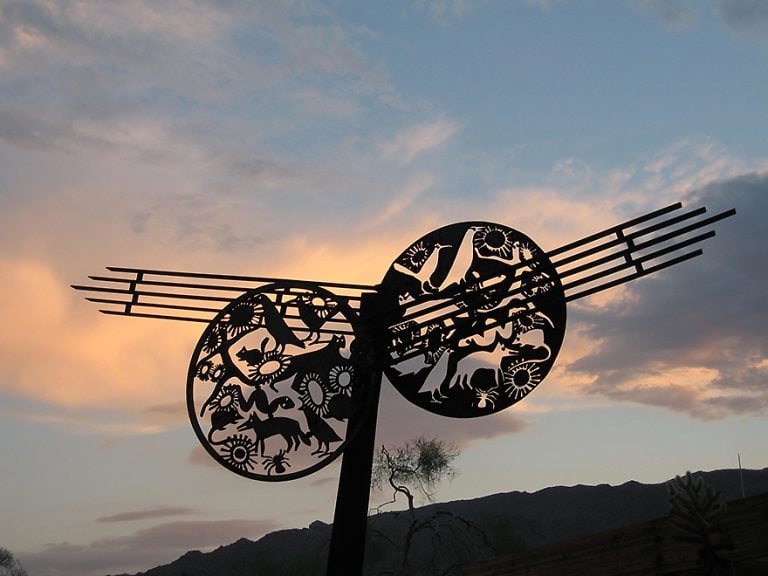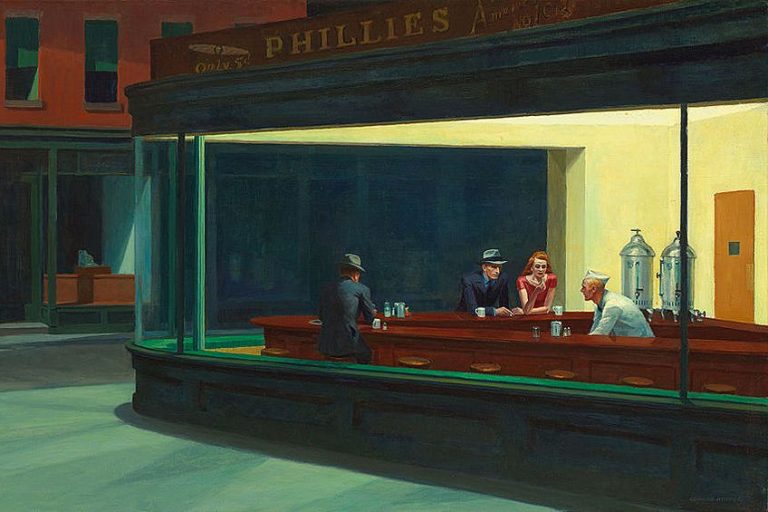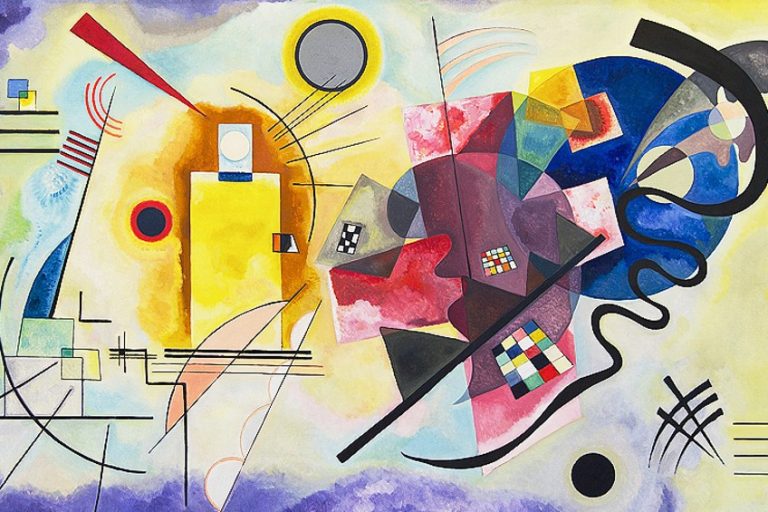Abstract Art – Looking at Famous Abstract Art and its Artists
Abstract Art is a non-representational art movement, also often referred to as being non-objective. Since the early 1900s, abstract artists portrayed a more subjective reality in their artworks, leaving interpretation and meaning up to the viewer. This moved away from how art depicted a literal portrayal of civilization and the natural world.
An Introduction to Abstract Art
When thinking about Abstract Art, a common question pops up: “What is Abstract Art?”. It is quite a broad topic and includes a wide selection of famous abstract art and artists, but again, we ask, “What is Abstract Art really?”. To answer this question, we need to mention early cave paintings and more modern abstract art from the 1900s.
Abstract Art goes all the way back to early cave paintings, when the natural and cosmic worlds were portrayed mostly as expressive lines, forms, and shapes – perhaps meant to be literal representations? However, the question arises as to whether these were meant to be literal portrayals or if there were hidden symbolic meanings related to the spiritual or metaphysical realms. Other earlier representations of abstract art are depicted as decorative forms and shapes on textiles or pottery throughout various cultures.
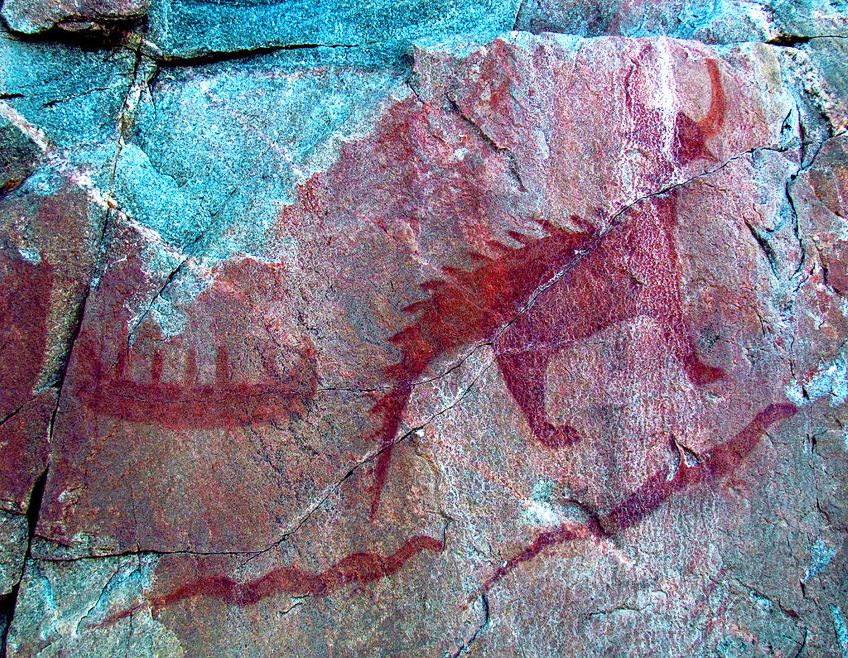
Although cave art can be named as a form of abstract representation due to its geometric and symbolic nature, the more modern Abstract Art movement is believed to have started during the late 19th and early 20th centuries when other art movements like Impressionism, Post-Impressionism, and Cubism, to name a few, had more prominence in the art world.
The above art movements radically shifted away from the traditional modes of how art was represented, such as the realistic portrayals of various aspects of life and nature. Additionally, these art movements changed the way media was used, such as in paint and sculpture, including the use of artistic principles like perspective and composition.
These were used with more expressive abandon by the abstract artists without worrying about abiding by the rules.
Art for Art’s Sake
Abstract Art became an expressive art form purely for the enjoyment of art, and many art sources point to the famous quote by French Philosopher, Victor Cousin, who said: “l’art pour l’art,” meaning “art for art’s sake”. This slogan simply means that art does not have to have any external meaning (political, social, or educational), other than just being art and enjoyed as such.
However, the term implies a lot more than the above; it makes a bold statement about freedom of expression through art, the meaning it conveys beyond social and political structures, and how aesthetics are judged by others. It was a widely adopted term within Modernism, spanning across multitudes of Modernist art movements and artworks. An example of this includes the infamous Fountain (1917) artwork by Marcel Duchamp, which is a toilet (selected by Duchamp himself) with “R.Mutt” signed on it in black.
Fountain is an example of how “art for art’s sake” is a contested term, as the artist received considerable rejection about this piece and critiques based on its aesthetic value. When Duchamp submitted the piece to the Society for Independent Artists in 1917, it was rejected due it being “immoral” in nature. This example questions the truth of the statement: Can art be for art’s sake? The many forms of how Abstract Art presents itself in the art world can also be viewed from this perspective.

An important point to remember about Abstract Art is that it was a movement across various art movements. In other words, it was a movement of art where the literal representation of an object was no longer a goal for artists. For example, a portrait of a woman sitting, a still life, or landscape. Instead, the object, and even the canvas, became saturated with an array of colors, shapes, lines, gestural movements, and splashes of paint.
This is evident in the artworks of well-known Abstract Expressionist, Jackson Pollock, who used dynamic movements like dripping and splashing to apply paint onto large canvases on the floor. The end results depicted multitudes of colors intermingling, and not in any seemingly predetermined order or composition.
This form of art was also referred to as Action painting, due to the dynamism of the process involved while painting, as Pollock had to actively move around the entire canvas.
How to Define Abstract Art
Many sources aim to define the term abstract in order to create a better understanding of the art movement itself. Referring to the meaning of the word “abstract”, we will see why it is called Abstract Art. As a verb, “abstract” means to separate or remove, and as an adjective, the term refers to the concept of not being based in fact, but instead being more theoretical and “disassociated” from something.
This can be viewed in terms of the subject matter of a painting, the paint itself, and the combination of lines, shapes, and colors, which seem far removed from the subject matter. If anything, these elements become the subject matter. Similarly, Abstract Art can also seem disassociated from reality, depicting the fundamentals of how colors and shapes interact with one another on a canvas.
Who Was the First Abstract Artist?
Many art and history sources point to Russian painter Wassily Kandinsky as the first artist to create abstract paintings, specifically starting with his piece Untitled (First Abstract Watercolor) in 1910. He pioneered Abstract Art by focusing on the relationship between forms and colors and how these compose pieces of art. In turn, these were enjoyed and experienced by the viewer.
Kandinsky valued the spiritual in art, his abstract paintings depicted the inner “transcendental” nature of existence, which became highly removed from the visual references of the everyday objects and life we all know. He expressed these inner truths through floating forms, amorphous shapes, and randomized linearity from intersecting lines and edges.
Most importantly, Kandinsky also believed in the importance of music and how it affected art.
He composed Abstract Art according to musical principles of how a musician would produce sound. Instead, he used colors and shapes to take his viewers on a sensory experience beyond the physical into the non-objective and non-representational dimensions of art.

Kandinsky’s important theoretical publication, Concerning the Spiritual in Art (1911), provides an in-depth look at the spiritual qualities of art and how the artist plays an important part as someone spiritual. The publication further explores the spirituality inherent within color, including the psychological aspects of color and how it is used. This was especially so in terms of how it relates to form and composition, which Kandinsky believed to be the “two weapons” at a painting’s disposal.
Kandinsky also discusses how music is the “best teacher” in that it has achieved non-objective expression throughout the ages instead of reproducing the world around it like painting does. His attitude is that music is ahead of painting in this regard, as it does not rely on an external quality to determine its “form”. He also states how painting has an advantage over music, in that it does not rely on time to showcase itself – the whole composition can be viewed “at one moment”.
Abstract Art Across Art Movements
Kandinsky intentionally sought to create Abstract Art and laid the foundation for other artists to do the same. He removed the expectations that art needs to be a direct representation of life and objects and pointed to a newfound freedom for artists to be open to experiment with different media and forms. This art woul be informed by their inner world and not the outer world. Although abstraction in art had been around for centuries, the purposeful intention to apply it to art was becoming realized.
Other art movements started using different techniques to hear that inner call within them and share it with the world. For example, art movements like Fauvism (a group of French artists called the Fauves, which means “wild beasts”) started exploring colors removed from how they occur on or were represented by natural objects.
In other words, colors had an independent meaning, and were a way to represent the artist’s inner, emotive, worlds.
It was the inner emotive world that was at the core of Fauvism, and the use of rich colors and forms set the tone for other art movements to come. Henri Matisse was at the forefront of Fauvism, inspiring other artists to similarly explore the use of colors and how they impact the forms and spatial aspects on a canvas.
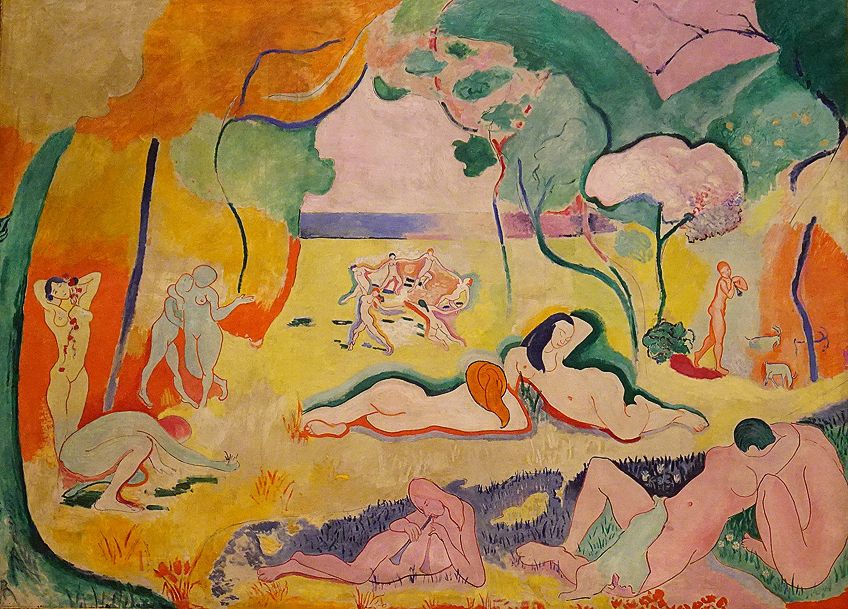
Another art movement worth mentioning is Cubism. Artists within this movement created geometric abstract art forms that were “fractured” and could be viewed from multiple angles. Artists also blended the foreground and backgrounds, and figures became cubic representations in a composition. Cubism was almost an opposite reaction to the rules of perspective and composition evident from the Renaissance art period.
A well-known artist from Cubism was Spanish-born Pablo Picasso, whose abstracted art depicted the above-mentioned move away from the traditional Renaissance rules of perspective. He also created collages, mixing different media to represent his ideas of art and the world. He said, “I paint objects as I think them, not as I see them,” which further emphasizes the removal from portraying art as a direct representation of the external world.
An important art movement to lead the way for the development of Abstract Art was Abstract Expressionism. It started in New York during the early and mid-1900s. Artists were influenced by the political and social aspects of the time, notably the Great Depression. Many artists from Europe also emigrated to New York and shared their artistic theories with American artists.
Hans Hofmann was a notable figure during this time as an artist and theorist. He was exposed to prominent artists from Cubism and Fauvism and taught the principles from these artists and movements. He is also considered a forefather, so to say, of Modernism. Many American artists wanted to create their own American art based on their experiences, instead of delving too deeply into European art, which was based on European experiences.

Important Concepts of Abstract Art
Below, we discuss important artistic techniques and concepts related to Abstract Art, specifically related to the focus on the non-representational manner of portraying art versus the traditional (identical to nature) style. Additionally, we look at the innovative techniques used to depict the artists’ inner expressions and emotions, as well as their use of diverse media.
Drip Technique
The drip technique became a popular mode of applying paint onto a canvas, and was specifically prevalent during the period of Abstract Expressionism. This is because the technique was given exposure by Jackson Pollock, who used it on his large canvases placed on the floor. This technique also pioneered Action painting, where the artist employs dynamic movements around a canvas to create it. This approach is wholly different to the traditional easel and canvas methods with paintbrushes, as paint would be dripped or splattered onto the canvas by not only brushes, but sticks and cigarettes too (as in the case of Jackson Pollock).
Perspective Shifts
Abstract artists would subvert the formal use of perspective and principles of depth in a painting by depicting geometric abstracted art forms and shape in a composition along with non-local colors. This created more emotionally charged scenes that would lead to interpretations beyond what is known to be real. Abstract paintings would often be exceptionally large and force viewers to enter its space and engage with it, ultimately evoking intense emotions throughout the process.
This was true of Mark Rothko’s paintings. He even wrote about the type of engagement and interpretation of his art, saying, “I realize that historically the function of painting large pictures is something very grandiose and pompous. The reason I paint them however…is precisely because I want to be intimate and human”.
Non-Representational
Depicting the non-representational was a key characteristic of Abstract Art, and as mentioned above, an abstract artist’s primary goal would be to refuse to depict life and its myriad of scenes and landscapes as it was directly seen. In other words, artists did not seek to represent the external world as was so widely accepted and expected during earlier art movements. When artists depicted the external world, this would be done with a freedom of inner expression. The focus was more on figurative concepts rather than literal meanings.

Shapes, Lines, Forms, and Textures
When looking at Abstract Art we will notice how various shapes, lines, and forms make up the compositions. These were the dominant visual tools used to create abstract paintings, evident in most of the artworks by abstract artists. Examples include Clyfford Still, who produced artworks with strong horizontal and vertical shapes. Another artist was Joan Miró, whose artworks depicted amorphous shapes and lines, seemingly floating in a space on the canvas.
Color and Color Field Paintings
In addition to the use of shapes and forms, color became an important visual tool and language with Abstract Art. Since the earlier European movements like Fauvism, color was used to depict the non-literal, including the aesthetic experience it evoked. Many abstract artists also studied the psychological aspects of color, namely Wassily Kandinsky. The Color Field movement emerged during the 1940s and 1950s, where artists used large areas of color, often with a monochromatic palette.
Geometric Abstract Art
Abstract Art is diverse with many facets – some theorists have even divided it into Geometric Abstract Art, which depicts shapes and forms with no connection to the natural world, and the fundamental structures that create form, namely lines. We see this style in the Cubist movement and later in works by artists like Piet Mondrian’s Composition with Large Red Plane, Yellow, Black, Gray, and Blue (1921) and Victor Vasarely’s Optical Art.
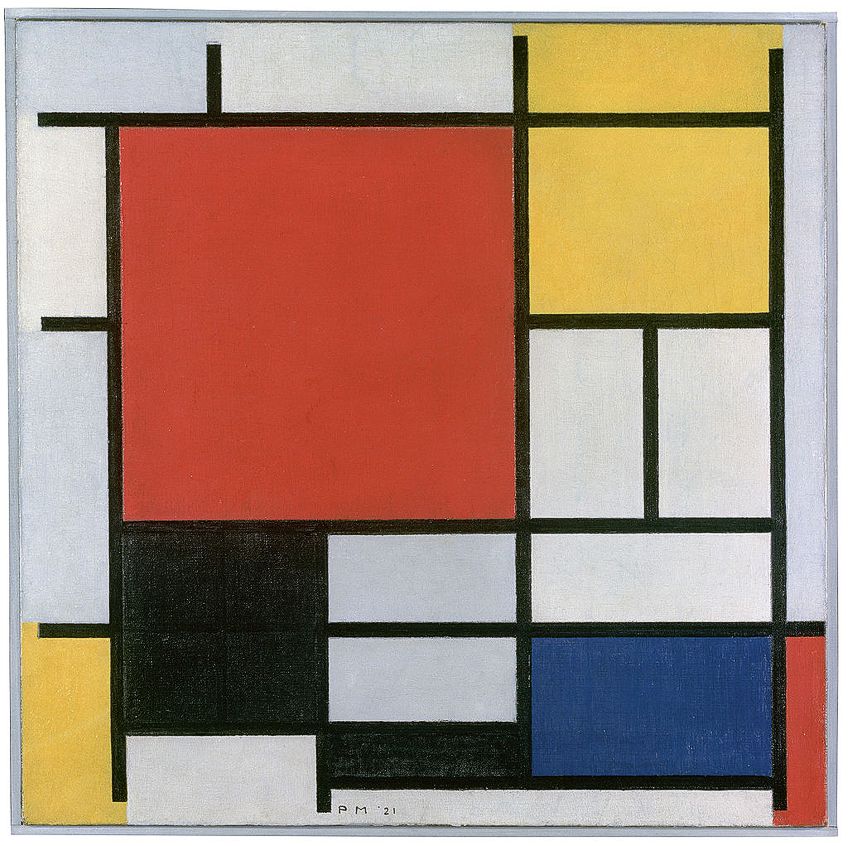
Some artists would still rely on calculation and planning while creating their works, but not all. For example, Piet Mondrian created a “visual rhythm” through his asymmetrical grids and did not intend calculation. He is quoted as saying in a letter to H.P. Bremmer, a Dutch artist, teacher, and critic:
“I believe it is possible that, through horizontal and vertical lines constructed with awareness, but not with calculation, led by high intuition and brought to harmony and rhythm, these basic forms of beauty – supplemented if necessary by other direct lines or curves – can become a work of art, as strong as it is true.”
Spirituality and Music in Abstract Art
Many artists like Wassily Kandinsky and Piet Mondrian believed in the underlying spiritual qualities of art and wanted to depict these in their artworks. Music was also a strong influence, especially for Wassily Kandinsky. Returning to the metaphysical aspects of existence allowed abstract artists to explore a deeper meaning in their subject matter.
Famous Abstract Artists
Below, we look at several noteworthy Abstract artists who not only pioneered Abstract Art, but also paved the way for many artists during its development. We look at Abstract artists and their artworks from different art movements. We will also identify what most artists shared, which was producing art removed from the traditional representations of life and nature, instead focusing more on the expressive nature of self.
Wassily Kandinsky (1866 – 1944)
Wassily Kandinsky was a Russian painter and theorist. He studied art during his school years at the Grekov Odessa Art School and went on to study law and economics at the University of Moscow. As a child growing up, he also learned to play the Cello and Piano, and was supported by his father in exploring his artistic talents, as he displayed a unique connection and response to sounds, colors, and words, which would later prove to inform his artistic abilities.
Some of Kandinsky’s popular artworks include Der Blaue Reiter (“The Blue Rider”, 1903), depicting a rider on a horse. However, here Kandinsky uses color to create a contrast of light and dark. This painting is one of Kandinsky’s earlier works and shows how the style of Impressionism influenced his brushwork and use of colors. It is also clear that he is moving away from the traditional modes of aesthetic portrayal in art and creating art that will eventually symbolize his belief in the spiritual.
Der Blaue Berg (“The Blue Mountain”, 1908) depicts riders on horses surrounded by two large trees on either side of the composition, and a blue mountain in the middle. Kandinsky’s use of color is not true to the natural appearance of how these aspects occur in real life and he uses expressive brushstrokes and dark outlines. We can also see the influence from Fauvism due to this use of colors and expressive brushwork.
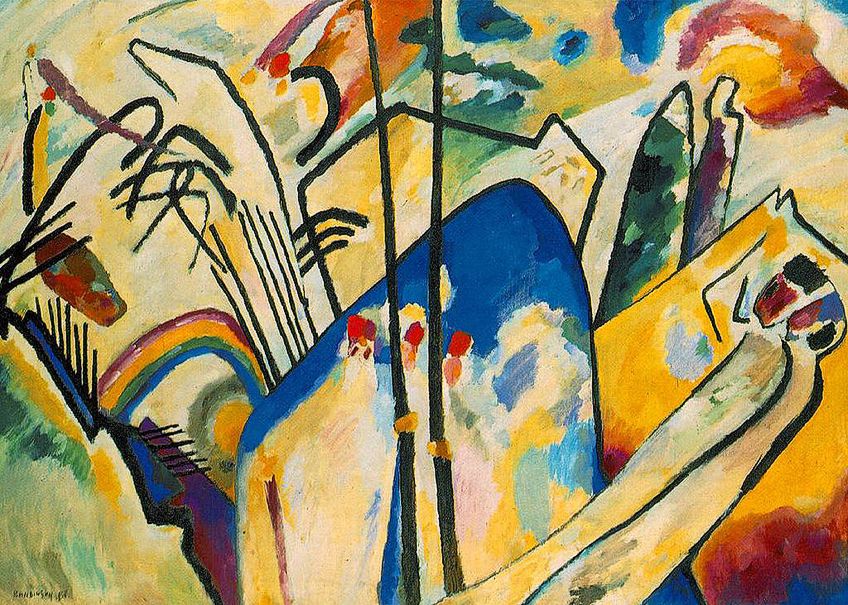
As Kandinsky developed in his art and spiritual beliefs, he started painting more abstract works, such as his popular Composition IV (1911). While this piece is abstracted, upon closer inspection we see various identifiable images like Cossacks carrying lances, boats, a castle, and figures in a reclining position. These figures are all portrayed with a non-objective symbolism.
We see them applied to many more of Kandinsky’s other artworks, such as in Composition VII (1913), Moscow I (Red Square) (1916), and Composition VIII (1913), among others. These abstract paintings depict the spiritual essence of what Kandinsky sought to portray from the subject matter. The composition of colors, lines, and shapes, all interplaying with one another, becomes the visual language. Although Kandinsky’s abstract paintings seem randomized and done on the spur of the moment, there is an intentionality and purpose to them.
For Composition VII (1913), the artist planned and produced around 30 sketches before he painted it. It appears almost ominous in its portrayal with a busyness from the different shapes, lines, and forms all intersecting and interplaying with the other. This is coupled with rich colors like blacks, dark blues, and reds, all combined to create new colors of off-greens, blues, and mustards. This work is also said to depict narratives from the Bible, for example, the Resurrection and the Garden of Eden.
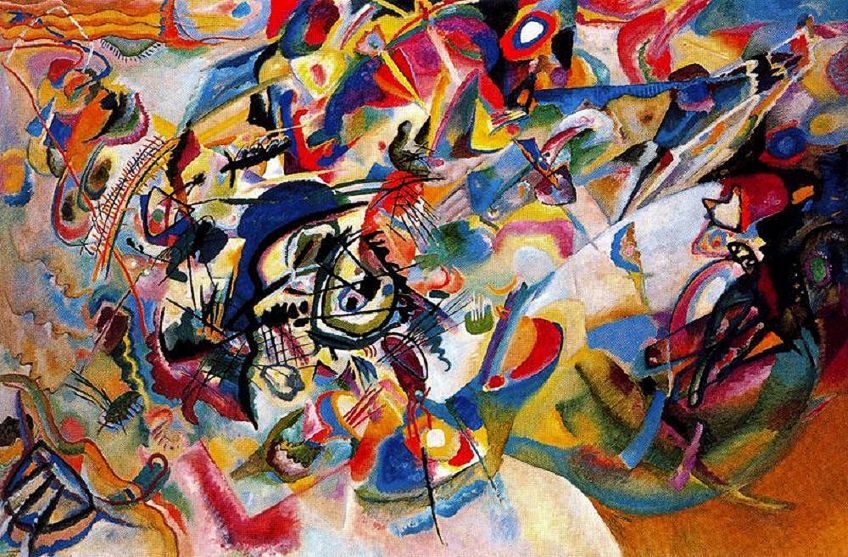
Hans Hofmann (1880 – 1966)
Hans Hofmann was born in Germany and emigrated to America in 1932. He showed great talent in various fields like art, science, and music. As a teenager, he worked for the Director of Public Works in Bavaria and patented numerous scientific inventions. When he was 18, he chose to continue his studies in art at the Moritz Heymann’s art school located in Munich. He worked as an artist in Paris until 1914, when he returned to Munich and started an art school.
Hofmann’s art school gained recognition in the art community and he started traveling to the United States, where he would eventually move to as a result of the war in Europe. He taught at the Art Students League in New York and, in 1933, he also opened another art school under his name, the Hans Hofmann School of Fine Arts. In 1935 he started a summer school in Provincetown, Massachusetts. His second solo exhibition was at the Peggy Guggenheim’s Art of This Century Gallery in 1944, with his first exhibition held during 1910 in Berlin.
Popular artworks by Hofmann include The Wind (c. 1944) and Effervescence (1944), which depicts the drip technique. Similarly, Jackson Pollock also used this technique, and there is debate around who started using the technique first. However, it is believed that both artists drew inspiration from André Masson’s artworks, which were rooted in images that explored subconscious, surreal aspects.
The above works by Hofmann explored a complete abstract reality on canvas, with large areas of color splashed and strewn around the canvas.
Hofmann’s other works include Pompeii (1959), which depicts large, square block areas of paint filling up the canvas in darker hues of reds, blues, pinks, and white mixed with blue, creating a lighter contrast. The background is completely red, hinting at the use or removal of spatial perspective. These were often termed as slab paintings, indicating the use of rectangles and squares within the rectangular shape of the canvas.
Mark Rothko (1903 – 1970)
Mark Rothko was an American Abstract Expressionist who was born in Latvia, but emigrated to the United States with his family in 1913. He was inspired to start his career as an artist when he saw a student sketch a model at the Art Students League of New York. After this, he joined the Parsons School of Design as a student and studied under instructors like Arshile Gorky, a painter and Abstract Expressionist. He also studied under Cubist Max Weber at the Art Students League.
Rothko worked in New York City’s Garment District, where he started in 1923, and became acquainted with well-known artists and their works. He also started giving art lessons for children at the Center Academy of the Brooklyn Jewish Center. Rothko was heavily influenced by the work of Milton Clark Avery, an abstract and modern painter, often referred to as the “American Matisse” due to his use of colors.
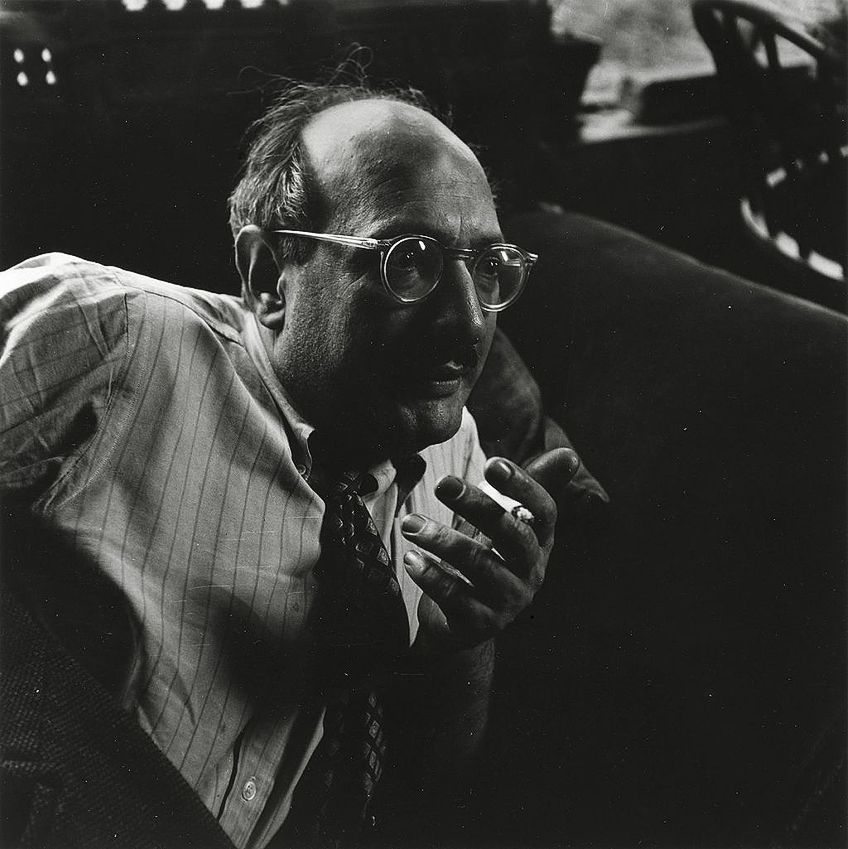
Rothko’s artworks evolved over the course of his life from Impressionistic portrayals of urban life and scenes to mythology-inspired abstract paintings. He was also influenced by the effects of World War II and would explore the idea of tragedy through publications like The Birth of Tragedy by Nietzsche and Greek tragedy writers like Aeschylus. His immersion in these topics led him to create more abstracted art that touched on the inner world instead of representing the external.
Oedipus (1944) is an example of Rothko’s artwork with a mythological theme, depicting a unique blend of human-like figures. It is inspired by the tale of Oedipus and the psychology of narratives like pride, passion, and the entanglement and interconnection we all share as humans. There are several figures in this composition appearing dismembered and re-membered in different areas. The background suggests a decorated interior and possibly a chair or plinth the figures are on.
Rothko’s later artworks include his popular large rectangular sections of solid paint and color. For example, Orange, Red, Yellow (1961), as the title suggests, is composed of three varying sizes of rectangular colors of yellow and orange against a red background. Each rectangular shape almost flows into the red background, without a solidifying border around it. Rothko applied his paint in thin layers, which also gave it the element of appearing brighter in hue.
Other similar works include Untitled, Black on Gray (1969), which depicts two rectangular shapes on the canvas. The top section is black with the bottom section in gray, and these were painted onto the white canvas without any priming, which Rothko would usually do.
This painting appears more severe in its use of color and evokes deeper feelings of sadness and possibly even death. Interpretations of this piece have been attached to lunar images, as well as night-time photography.
Jackson Pollock (1912 – 1956)
Jackson Pollock is one of the well-known artists from the American art movement, Abstract Expressionism. Pollock was born in Wyoming but grew up in a couple of cities in California. During the 1930s, he moved to New York City with his brother, Charles Pollock, who was also an abstract painter. Both brothers studied at the Art Students League under Thomas Hart Benton, who was part of the Regionalist Art movement.
Pollock was inspired by the artworks of Mexican muralists, and was shown how to use liquid paint at a workshop in New York City by David Alfaro Siqueiros, a Mexican muralist. From here, he incorporated the technique of pouring paint onto his canvases, which developed into his signature drip technique.

Pollock produced various important artworks during the 1940s, but it is worth noting some of his earlier paintings before his drip paintings became the highlight of his painting career. Going West (1934-35) is a figurative work done in oil paint. It depicts a family moving to the west with their horses and carriages. There are different meanings attached to this artwork, one being that Pollock drew on memories when he moved west (Arizona to California) with his family, and that it was from a photo of a bridge in Wyoming.
Going West appears dark in color with brushwork that is more fluid and swirling in its technique. This is a different painting style to Pollock’s later works, also indicating his skill as an artist in conveying different narratives with paint and brushwork.
This work is also reminiscent of Van Gogh’s and El Greco’s styles, which also depicted swirls of paint, creating more emotional intensity within the frame.
Mural (1943) is an early drip painting by Pollock, and is 8 x 20 feet in size. Pollock started working on large canvases placed on the floor and would use his whole body to create an artwork. This dynamism and force of movement around his canvas was referred to as Action painting. Mural was influenced by other popular artists like Pablo Picasso, Thomas Hart Benton, and Native American sand painting.
The above work by Pollock depicts what appears to be numerous moving figures in swirls of multi-color paint. The brushstrokes appear thick and thin in areas, which also adds to the dynamic flow of the artwork. The thick arcs of black lines stand out among the more pastel colors of yellows , pinks, and blues. This work was commissioned by Peggy Guggenheim.
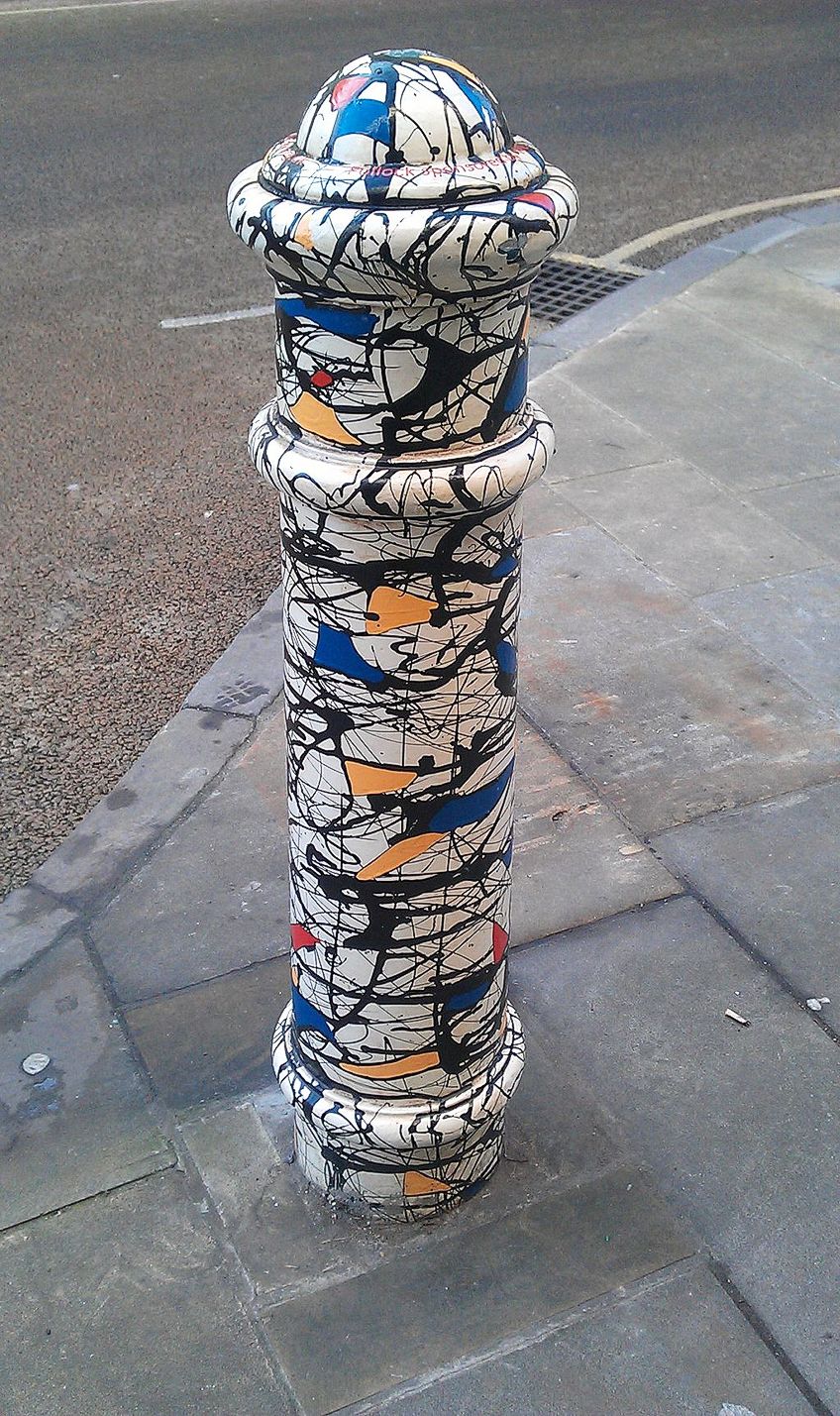
Another famous drip painting by Pollock is Autumn Rhythm: Number 30 (1950), also one of the artworks that were a part of Pollock’s solo exhibition, which gained positive media attention. Pollock started this work with a diluted mix of black paint over the entire horizontal surface of the canvas. Over this he incorporated a mix of different subdued colors like blacks, whites, and tones of beige and brown. The paint is strewn over the canvas in thin and thick drips of paint, each following its own path along the canvas, intersecting and melting into one another. In this painting, the colors and dynamic flow have an autumnal feel and rhythm about it them, as described so aptly in the title.
While there were many very well-known Abstract artists (across different art movements) who created their own unique “brand” of Abstract Art, the above explores several popular names we have all come to know because of their pioneering, innovative, and imaginary perspectives that led the way for other artists.
The Death (and Life) of Abstract Art
Although some sources state that Abstract Art was “declared dead” almost 40 years ago, it is not entirely true. Abstract Art still lives on into the 21st Century and may have reached its pinnacle near the end of Abstract Expressionism. During this time period, Minimalism became the dominant art movement, with a group of artists focused more on the elements used in Abstract Art like forms, lines, shapes, and colors, but without their personal expression informing the artwork’s subject matter.
Abstract Art in the 21st Century is as diverse as it was at the start of the 19th Century. Presently, there are hundreds of abstract artists creating non-representational paintings, sculptures, and installations that transcend the boundaries of what art is supposed to be and how media is supposed to be used.
Furthermore, the digital age has brought with it a new rise in representation, as well as how colors, forms, and symbols are used (newly created and borrowed from the old) to portray not only life, but aspects of the metaphysical, spiritual, and the worldwide effects of globalization and a world that is vastly different to the that from almost a century before. All these elements will undoubtedly further the evolution of Abstract Art far beyond the 21st Century.
Frequently Asked Questions
What Is Abstract Art?
Abstract Art started in the 20th Century and moved away from the more traditional representational way in which art was depicted, such as compared to the Renaissance period, where artists painted what they saw. Abstract artists placed more emphasis on expressing their emotions and inner interpretations of life, often reflecting upon deeper aspects like spirituality and the metaphysical. They would portray these deeper meanings by using different colors and forms. Through the act and process of creating their artworks, Abstract artists created a completely new subject matter.
What Are the Main Characteristics of Abstract Art?
Many sources point to the main elements that make Abstract Art, which include a focus on visual aspects and motifs like lines, shapes, colors, forms, and different textures. These were used in various manners on the canvas, and often arranged in non-logical or aesthetically pleasing ways. Canvases would often be placed on the floor, allowing for more dynamic movements from the artists, which was a characteristic widely seen during Abstract Expressionism.
Was Abstract Art One Art Movement?
No, Abstract Art occurred across different art movements, including Fauvism, Cubism, Abstract Expressionism, and other movements like Surrealism. Abstract Art can even be said to have occurred in early cave paintings, but as an official art movement its foundations are believed to have started during art movements like Post-Impressionism in France during the late 1800s.
Who Were the Famous Abstract Artists?
Wassily Kandinsky is believed to be the forerunner of Abstract Art. He was a Russian painter who used color much like a musician made music. Music also informed a large part of Kandinsky’s artworks and he sought to use his paintings and colors to symbolize the spiritual in art. Another famous Abstract artist, Jackson Pollock, pioneered a style referred to as Action painting. He created artworks on large canvases by pouring or flicking paint on it in different ways. He would often use other media with his paint, such as sand. Another artist was Pablo Picasso, one of the forerunners of Cubism. He was also famous for creating his collages, which would often be composed by parts of posters, newspapers, magazine cuttings, as well as other elements like wires. This style, coupled with the geometric and deconstructed imagery that was characteristic of Cubism, created a new type of Abstract Art.
Isabella studied at the University of Cape Town in South Africa and graduated with a Bachelor of Arts majoring in English Literature & Language and Psychology. Throughout her undergraduate years, she took Art History as an additional subject and absolutely loved it. Building on from her art history knowledge that began in high school, art has always been a particular area of fascination for her. From learning about artworks previously unknown to her, or sharpening her existing understanding of specific works, the ability to continue learning within this interesting sphere excites her greatly.
Her focal points of interest in art history encompass profiling specific artists and art movements, as it is these areas where she is able to really dig deep into the rich narrative of the art world. Additionally, she particularly enjoys exploring the different artistic styles of the 20th century, as well as the important impact that female artists have had on the development of art history.
Learn more about Isabella Meyer and the Art in Context Team.
Cite this Article
Isabella, Meyer, “Abstract Art – Looking at Famous Abstract Art and its Artists.” Art in Context. April 12, 2021. URL: https://artincontext.org/abstract-art/
Meyer, I. (2021, 12 April). Abstract Art – Looking at Famous Abstract Art and its Artists. Art in Context. https://artincontext.org/abstract-art/
Meyer, Isabella. “Abstract Art – Looking at Famous Abstract Art and its Artists.” Art in Context, April 12, 2021. https://artincontext.org/abstract-art/.




